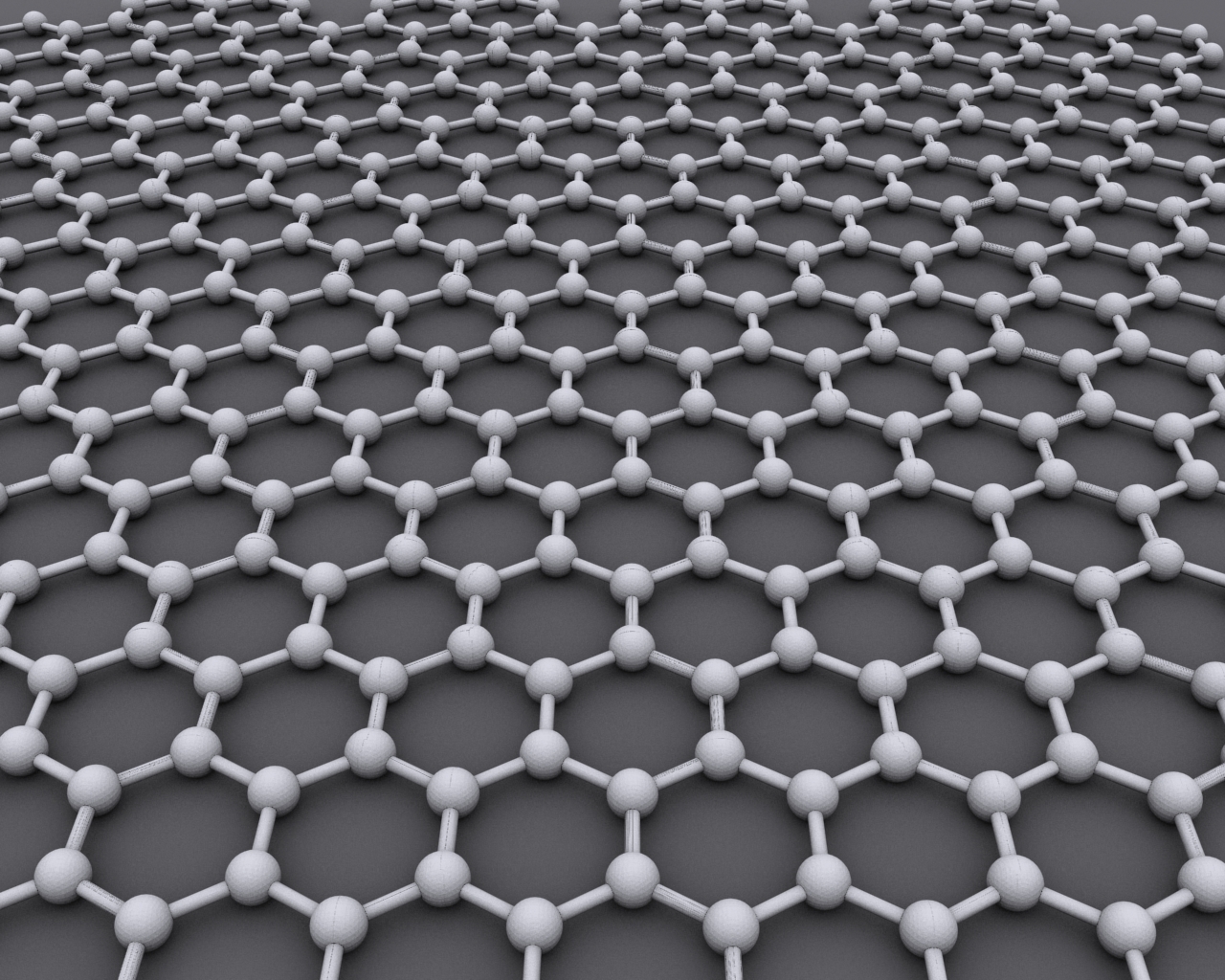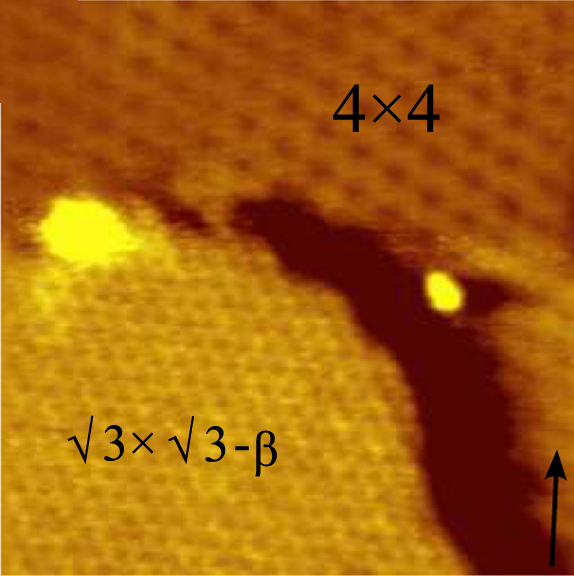|
Goldene
Goldene is a single-layer allotrope of gold. The thinnest commercial gold leaf is some 400 times thicker than goldene. It features 9% lattice contraction compared to bulk gold. History Goldene was first synthesized as a free-standing material in 2024 by a team at Linköping University in Sweden. A 2022 claim by a team at New York University Abu Dhabi has been disputed as actually containing multiple layers. Synthesis The team used a material containing silicene between layers of titanium carbide. Gold layered on top of this combination diffused into the structure and replaced the silicon. Etching away the titanium carbide released free-standing goldene sheets that were up to 100 nanometres wide. The etching was performed using Murakami's reagent, in a 100-year-old technique used to decorate ironwork by Japanese blacksmiths. Surfactant molecules formed a barrier between goldene and the surrounding liquid — to stop the sheets from adhering. The team is exploring the poten ... [...More Info...] [...Related Items...] OR: [Wikipedia] [Google] [Baidu] |
Single-layer Materials
In materials science, the term single-layer materials or 2D materials refers to crystalline solids consisting of a single layer of atoms. These materials are promising for some applications but remain the focus of research. Single-layer materials derived from single elements generally carry the -ene suffix in their names, e.g. graphene. Single-layer materials that are compounds of two or more elements have -ane or -ide suffixes. 2D materials can generally be categorized as either 2D allotropes of various elements or as compounds (consisting of two or more covalently bonding elements). It is predicted that there are hundreds of stable single-layer materials. The atomic structure and calculated basic properties of these and many other potentially synthesisable single-layer materials, can be found in computational databases. 2D materials can be produced using mainly two approaches: top-down exfoliation and bottom-up synthesis. The exfoliation methods include sonication, mechanical, h ... [...More Info...] [...Related Items...] OR: [Wikipedia] [Google] [Baidu] |
Gold Leaf
upA gold nugget of 5 mm (0.2 in) in diameter (bottom) can be expanded through hammering into a gold foil of about 0.5 m2 (5.4 sq ft). The Japan.html" ;"title="Toi gold mine museum, Japan">Toi gold mine museum, Japan. Gold leaf is gold that has been hammered into thin sheets (usually around 0.1 μm thick) by a process known as goldbeating, for use in gilding. Gold leaf is a type of metal leaf, but the term is rarely used when referring to gold leaf. The term ''metal leaf'' is normally used for thin sheets of metal of any color that do not contain any real gold. Gold leaf is available in a wide variety of karats and shades. The most commonly used gold is 22-karat yellow gold. Pure gold is 24 karat. Real, yellow gold leaf is approximately 91.7% pure (i.e. 22-karat) gold. Traditional water gilding is the most difficult and highly regarded form of gold leafing. It has remained virtually unchanged for hundreds of years and is still done by hand. History Mycenaean neckla ... [...More Info...] [...Related Items...] OR: [Wikipedia] [Google] [Baidu] |
Allotrope
Allotropy or allotropism () is the property of some chemical elements to exist in two or more different forms, in the same physical state, known as allotropes of the elements. Allotropes are different structural modifications of an element: the atoms of the element are bonded together in different manners. For example, the allotropes of carbon include diamond (the carbon atoms are bonded together to form a cubic lattice of tetrahedra), graphite (the carbon atoms are bonded together in sheets of a hexagonal lattice), graphene (single sheets of graphite), and fullerenes (the carbon atoms are bonded together in spherical, tubular, or ellipsoidal formations). The term ''allotropy'' is used for elements only, not for compounds. The more general term, used for any compound, is polymorphism, although its use is usually restricted to solid materials such as crystals. Allotropy refers only to different forms of an element within the same physical phase (the state of matter, such as ... [...More Info...] [...Related Items...] OR: [Wikipedia] [Google] [Baidu] |
Gold
Gold is a chemical element; it has chemical symbol Au (from Latin ) and atomic number 79. In its pure form, it is a brightness, bright, slightly orange-yellow, dense, soft, malleable, and ductile metal. Chemically, gold is a transition metal, a group 11 element, and one of the noble metals. It is one of the least reactivity (chemistry), reactive chemical elements, being the second-lowest in the reactivity series. It is solid under standard temperature and pressure, standard conditions. Gold often occurs in free elemental (native state (metallurgy), native state), as gold nugget, nuggets or grains, in rock (geology), rocks, vein (geology), veins, and alluvial deposits. It occurs in a solid solution series with the native element silver (as in electrum), naturally alloyed with other metals like copper and palladium, and mineral inclusions such as within pyrite. Less commonly, it occurs in minerals as gold compounds, often with tellurium (gold tellurides). Gold is resistant to ... [...More Info...] [...Related Items...] OR: [Wikipedia] [Google] [Baidu] |
Linköping University
Linköping University (LiU; ) is a public university, public research university based in Linköping, Sweden. Originally established in 1969, it was granted full university status in 1975 and is one of Sweden's largest academic institutions. The university has four campuses across three cities: Campus Valla and Campus US in Linköping, Campus Norrköping in Norrköping and Campus Lidingö in Stockholm. It is organized into four faculties: Arts and Sciences; Medicine and Health Sciences; Science and Engineering (also referred to as the Linköping Institute of Technology, Institute of Technology); and Educational Sciences. To facilitate interdisciplinary work, there are 12 large departments combining knowledge from several disciplines and often belonging under more than one faculty. In 2021 the university had 35,900 students and 4,300 employees. Linköping University emphasizes dialogue with the surrounding business sphere and the community at large, both in terms of research and ... [...More Info...] [...Related Items...] OR: [Wikipedia] [Google] [Baidu] |
New York University Abu Dhabi
New York University Abu Dhabi (NYUAD, ) is a degree-granting portal campus of New York University, established as a private liberal arts college in Abu Dhabi, United Arab Emirates. Together with the main sites in New York and Shanghai, the portal campus is part of NYU's Global Network University. It started in 2008 as a temporary site for conferences and cultural events. The academic program opened in September 2010 at the university's provisional downtown site. It was moved permanently in 2014 to Saadiyat Island, Abu Dhabi. The university has produced 22 Rhodes Scholars since its opening in 2010. New York University Abu Dhabi is accredited by the Commission for Academic Accreditation (CAA), the UAE Federal Government's quality assurance agency for higher education. NYUAD is also accredited as an additional location of NYU by the Middle States Commission on Higher Education, an institutional accreditation agency recognized by the US Secretary of Education and the Council for ... [...More Info...] [...Related Items...] OR: [Wikipedia] [Google] [Baidu] |
Silicene
Silicene is a two-dimensional allotrope of silicon, with a hexagonal honeycomb structure similar to that of graphene. Contrary to graphene, silicene is not flat, but has a periodically buckled topology; the coupling between layers in silicene is much stronger than in multilayered graphene; and the oxidized form of silicene, 2D silica, has a very different chemical structure from graphene oxide. History Although theorists had speculated about the existence and possible properties of free-standing silicene, researchers first observed silicon structures that were suggestive of silicene in 2010. Using a scanning tunneling microscope they studied self-assembled silicene nanoribbons and silicene sheets deposited onto a silver crystal, Ag(110) and Ag(111), with atomic resolution. The images revealed hexagons in a honeycomb structure similar to that of graphene, which, however, were shown to originate from the silver surface mimicking the hexagons. Density functional theory (DFT) ca ... [...More Info...] [...Related Items...] OR: [Wikipedia] [Google] [Baidu] |
Titanium Carbide
Titanium carbide, Ti C, is an extremely hard ( Mohs 9–9.5) refractory ceramic material, similar to tungsten carbide. It has the appearance of black powder with the sodium chloride (face-centered cubic) crystal structure. It occurs in nature as a form of the very rare mineral () - (Ti,V,Fe)C. It was discovered in 1984 on Mount Arashan in the Chatkal District, USSR (modern Kyrgyzstan), near the Uzbek border. The mineral was named after Ibragim Khamrabaevich Khamrabaev, director of Geology and Geophysics of Tashkent, Uzbekistan. Its crystals as found in nature range in size from 0.1 to 0.3 mm. Physical properties Titanium carbide has an elastic modulus of approximately 400 GPa and a shear modulus of 188 GPa. Titanium carbide is soluble in solid titanium oxide, with a range of compositions which are collectively named "titanium oxycarbide" and created by carbothermic reduction of the oxide. Manufacturing and machining Tool bits without tungsten content can be made of tit ... [...More Info...] [...Related Items...] OR: [Wikipedia] [Google] [Baidu] |
Ironwork
Ironwork is any weapon, artwork, utensil, or architectural feature made of iron, especially one used for decoration. There are two main types of ironwork: wrought iron and cast iron. While the use of iron dates as far back as 4000 BC, it was the Hittites who first knew how to extract it (see iron ore) and develop weapons. Use of iron was mainly utilitarian until the Middle Ages; it became widely used for decoration in the period between the 16th and 19th century. Wrought iron Wrought ironwork is forged by a blacksmith using an anvil. The earliest known ironwork are beads from Jirzah in Egypt dating from 3500 BC and made from meteoric iron with the earliest use of smelted iron dates back to Mesopotamia. However, the first use of conventional smelting and purification techniques that modern society labels as true iron-working dates back to the Hittites in around 2000 BC. Knowledge about the use of iron spread from the Middle East to Greece and the Aegean region by 1000 BC and ... [...More Info...] [...Related Items...] OR: [Wikipedia] [Google] [Baidu] |
Blacksmiths
A blacksmith is a metalsmith who creates objects primarily from wrought iron or steel, but sometimes from other metals, by forging the metal, using tools to hammer, bend, and cut (cf. tinsmith). Blacksmiths produce objects such as gates, grilles, railings, light fixtures, furniture, sculpture, tools, agricultural implements, decorative and religious items, cooking utensils, and weapons. There was a historical distinction between the heavy work of the blacksmith and the more delicate operations of a whitesmith, who usually worked in gold, silver, pewter, or the finishing steps of fine steel. The place where a blacksmith works is variously called a smithy, a forge, or a blacksmith's shop. While there are many professions who work with metal, such as farriers, wheelwrights, and armorers, in former times the blacksmith had a general knowledge of how to make and repair many things, from the most complex of weapons and armor to simple things like nails or lengths of chain. Etymol ... [...More Info...] [...Related Items...] OR: [Wikipedia] [Google] [Baidu] |






